22 new speed bumps* have been installed on Northeast Ainsworth between NE Grand/6th and 15th. Almost as soon as they went in, I heard from various sources that they weren’t doing anything to slow people down. Since I ride this route and it’s an important neighborhood street with a history of speeding and tensions between drivers and bike riders, I wanted to get a closer look at these bumps.
So I headed over with my cameras to document how they’re being used.
According to the Portland Bureau of Transportation, they installed speed cushions in both directions of NE Ainsworth between NE Grand and 15th last week. There are 11 speed cushions in each direction.


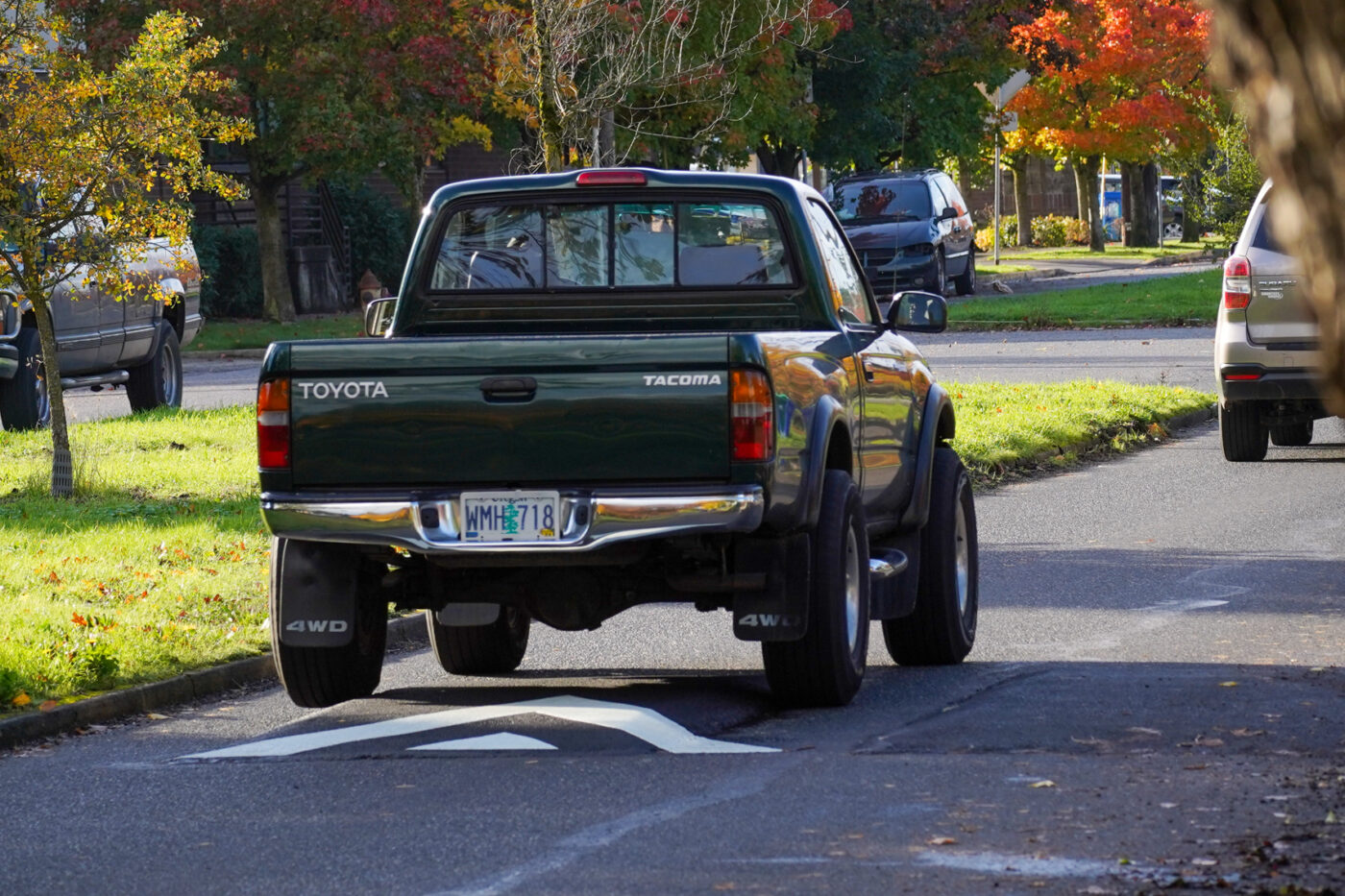

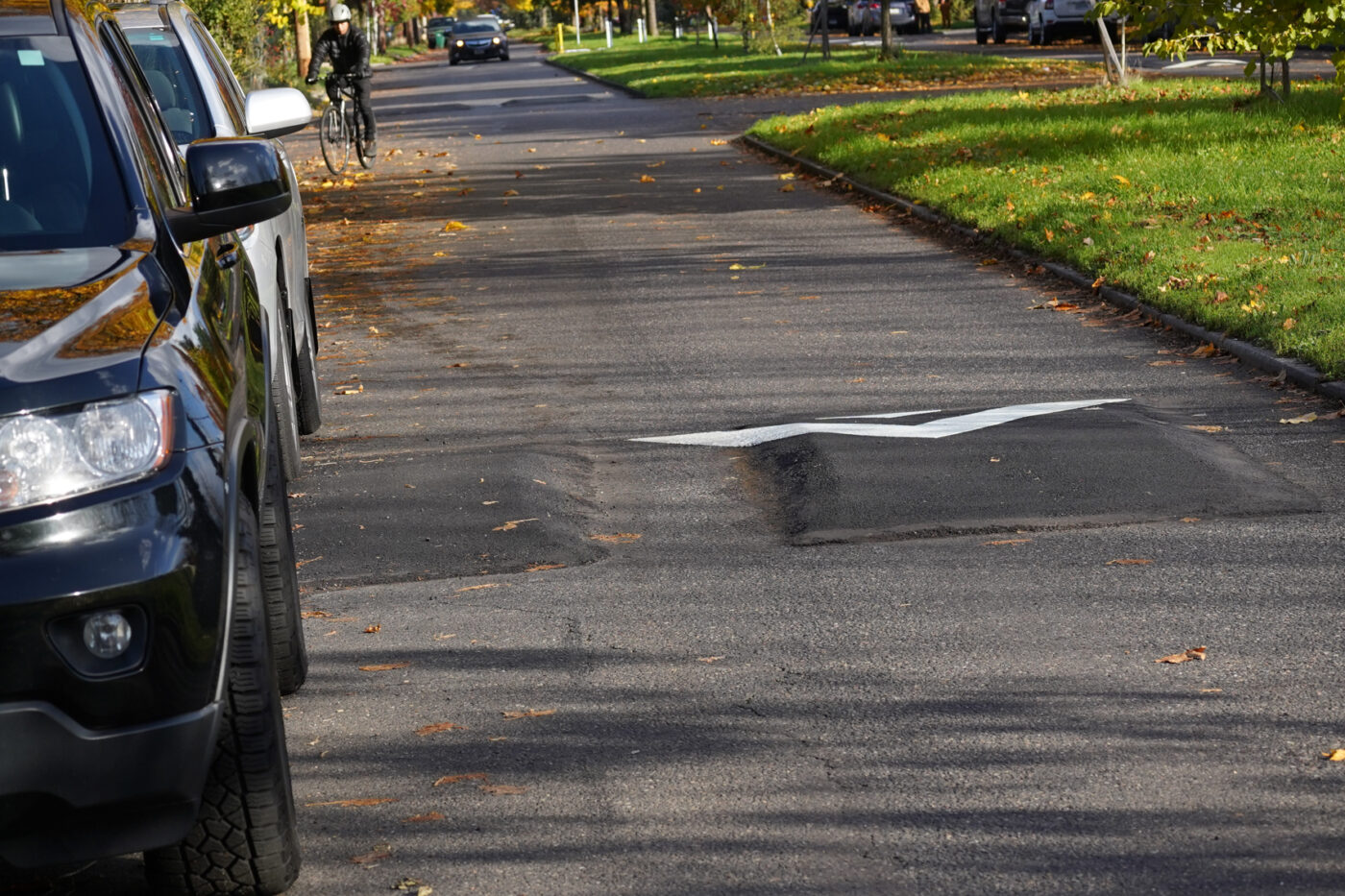
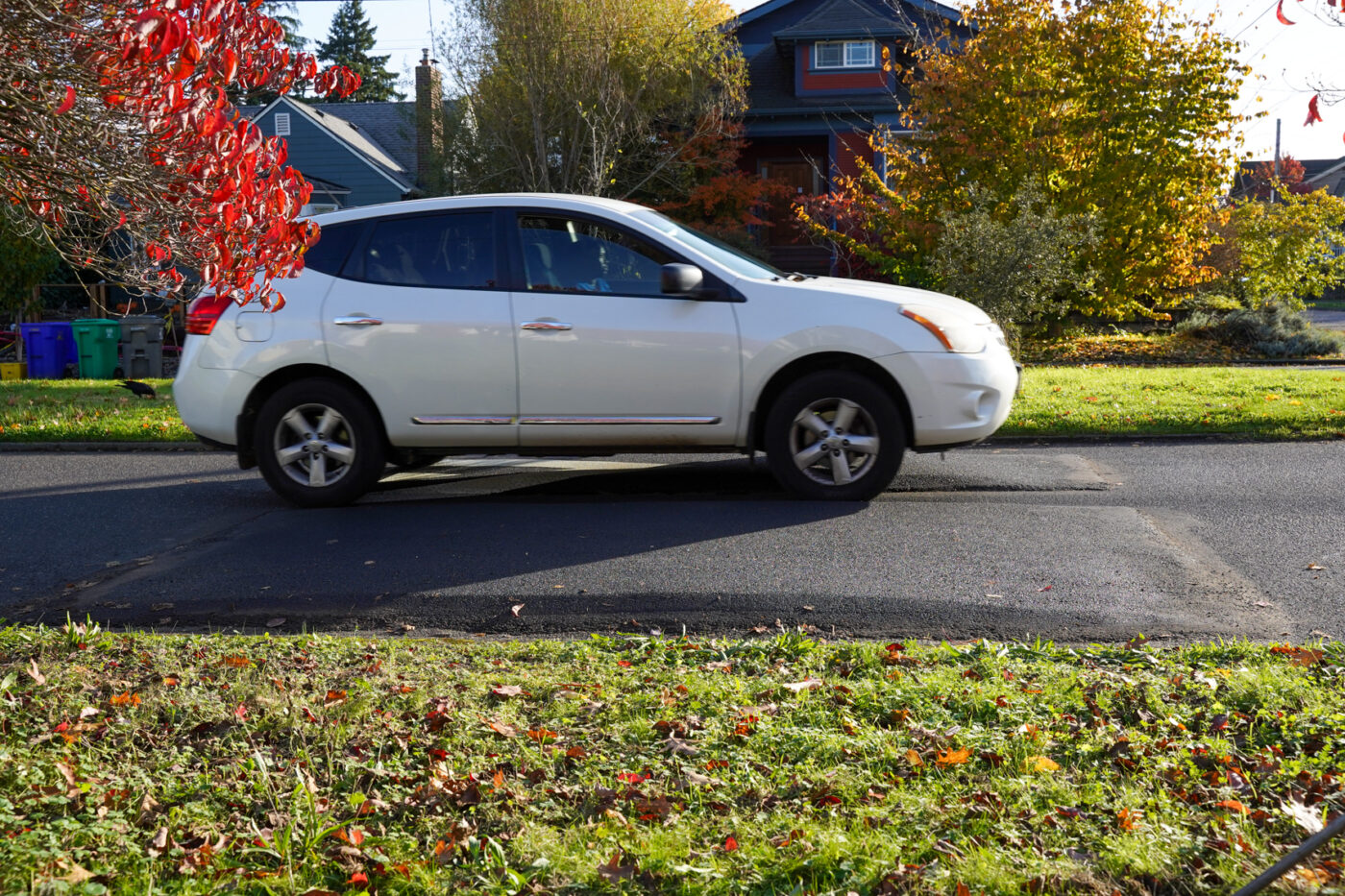
(*A quick note on verbiage: I’ve always called these speed “bumps” because that’s the general term most folks understand. But I realize there’s an important difference between speed bumps and speed “cushions” (a.k.a. “humps” or “tables”). Speed cushions, according to the National Association of City Transportation Officials (NACTO) have cutouts for wheels and elongated humps that are much less intrusive to auto users. From here on out, I will differentiate and use “cushions” to match PBOT’s language.)
Like I shared back in June, this section of NE Ainsworth has a 20 mph speed limit that is regularly exceeded by drivers. This is a problem because it’s two very narrow streets (so narrow that people who park on it often roll up onto the curb and sidewalk strip) separated by a wide grassy median in a dense residential neighborhood that is often shared by bicycle riders and drivers. It should be a pleasant, safe place to be; but with so many speeders it can be intimidating.
As for bicycling on it? I know there are many people who think bikes don’t belong, but I personally favor Ainsworth over the nearby neighborhood greenway on Holman because it’s much smoother and more direct. I only use it if I feel like going fast, which is easier these days with my e-bike that can maintain 20 mph with ease. The thought of speed bumps was exciting because it could mean that I (and others) would be able to use Ainsworth at or near the speed limit without being harassed by drivers who insist on tailgating (or worse) and going too fast.
What I found from personal observation is that they will likely have some impact, but the cushions are easy to avoid — especially for larger, wider vehicles that make up an increasingly larger portion of the fleet — and many people simply go over them without slowing down at all.
PBOT says Ainsworth is a secondary emergency route (NE Dekum a few blocks north is the main one), so their only option to address speeding was to install cushions. This installation is part of a larger effort to reduce and tame cut-through traffic on residential streets. PBOT understands that Ainsworth further west is a vital link in the bike network that carries a lot of bike traffic even without much dedicated bike infrastructure (they also recently installed bike boxes at N Interstate as part of a future neighborhood greenway as per the North Portland in Motion plan).
So do these new speed cushions work? My first impression is yes and no.

You can see a lot of evidence in my video and photos that many people speed right over them, using the channels meant for emergency vehicles. Some folks in larger vehicles might not even know the cushions exist. That being said, you’ll also notice some people do feel the cushions and slow down and/or attempt to navigate around them. Those behaviors mean they’re having some impact that will lead to lower speeds overall. I also think the symbolism of infrastructure is important. And these cushions send a signal to people that the city expects them to drive more slowly and use caution on this street.
What about the harassment and road ragers who tailgate bike riders on this street? Don’t miss the end of my video where I test this by riding 20 mph and filming drivers behind me. You’ll see some folks give plenty of breathing room, but others are clearly peeved they can’t drive faster. One guy in a truck was so mad he dangerously tailgated the driver immediately behind me and then yelled an obscenity at me as he turned off.
Six months from now PBOT says they’ll have speed data to report and I’m eager to see what they find.
Regardless of the impact this has on safety or cut-through traffic, one guy who I met while I was out there summed up what I think is a very important point: “It’s such a waste we had to spend money on these things just because people won’t drive the speed limit.”
Bingo!



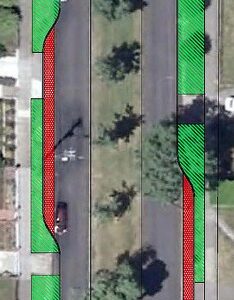

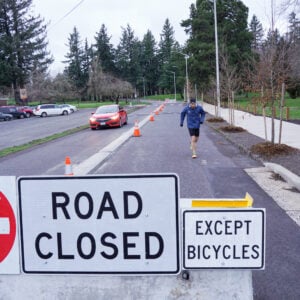
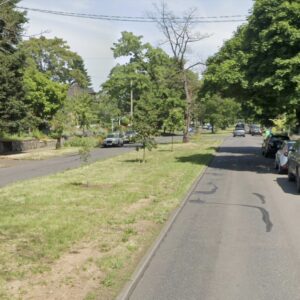
Thanks for reading.
BikePortland has served this community with independent community journalism since 2005. We rely on subscriptions from readers like you to survive. Your financial support is vital in keeping this valuable resource alive and well.
Please subscribe today to strengthen and expand our work.
What I would like to see is a comparison of the effects on public safety of lowering speed limits versus increasing response time. More specifically, is there a point where the reduction in likelihood of serious crashes offsets the increase in risk caused by increasing emergency response time?
This should be quantifiable. Googling around, it seems that typical speed bumps cause an increase of up to 10 seconds. I think other values (how much does this impact results, how much did the speed bumps reduce speeding, how much did that reduce crashes) should be studied.
I’d like to see this as well, having posited a similar idea in other threads. At what point does making our streets more dangerous in order to speed up emergency response provide not just diminishing returns, but negative returns?
This was about ten years ago when I still lived in East Portland, but I attended some event that had fire truck drivers from the 122nd station there for some reason, so I asked them about the speed humps on SE Market between 122nd & 130th. The fire truck drivers themselves don’t really care about speed humps one way or another – by the time they get to such a street that has them, usually a minor collector or neighborhood cut-through, they are already slowing down to get near the fire or emergency and are generally more worried about parked cars, people in the way, that sort of thing. They use the busy arterial stroads for long-distance travel. The Fire Bureau people who actually give grief to PBOT officials about speed humps are downtown at the central station, Fire officials who generally don’t drive fire trucks, but who are paid to give grief to officials from other city agencies such as PBOT.
The cutouts in speed humps seem to work best when they’re in the center of a two-lane street, such that an emergency vehicle could use them when cars pull over to the sides, but two cars passing each other in opposite directions cannot. The setup here with one-way streets separated by the wide median means that cars can just line up with the slots and drive like that down the length of the street, as there’s nothing forcing them to drive over the bumps.
I guess it’s better than nothing? Maybe stop signs would help more?
Watching the video made me wonder if the additional focus required to line up with the slots in the speed cushions means drivers will pay more attention to driving. It’s likely harder to send a text message and align your car with the slot at the same time. However, I could also see someone’s attention being diverted to focusing on avoiding the speed cushion resulting in them not seeing a pedestrian or something.
The real trick is to line up the slots as you send a text message, adjust the radio, AND drink your coffee.
… all during a publicly broadcast zoom meeting.
And that’s why I don’t ride Ainsworth. Same deal with Knott. Both absolutely beautiful 20 mph streets providing excellent connections, but even when going over 20 mph you get tailgated, passed, yelled at, etc. I wouldn’t say the jury is still out. The humps clearly don’t do squat. They need to convert the parking lane to bike/pedestrian only because drivers just cannot be expected to behave.
The speed humps are basically worthless, even a smallish car (I have a Jetta) completely avoids them. They are more of burden to people biking than to people driving, but they are barely an obstacle to anyone- just an irresponsible waste of resources by PBOT who refuses to uses simple, effective and proven methods like diverters to create safe places to cycle. PBOT is exclusively focused on servicing drivers- believe what they do, not what they say.
Hear hear. I’ll take one diverter over one hundred barely noticable speed cushions.
“I also think the symbolism of infrastructure is important.”
It is, except that in this case I’d argue that the symbolism says
PBOT has no clue how to actually install infrastructure that would slow you down so have fun ignoring the ostensible purpose of this tax-payer-funded-nonsense just like you can at SE Ankeny and 15th where the ‘diverters’ are spaced wide enough apart to allow *cars* to pass through!!
https://bikeportland.org/2018/12/14/new-diverters-on-ankeny-and-lincoln-part-of-plan-to-keep-drivers-off-side-streets-293190
Not to rain on your “PBOT is clueless” party, but that’s almost certainly intentional, to allow police cars to pass through.
Strange – in all these years no one has ever brought this up. I think you’re funnin’. The concrete tubs that were at 15th & Ankeny before the permanent ‘diverters’ would have admitted slender police on bikes but not cruisers.
I thought it was common knowledge.
The inconsistency of these is absolutely ridiculous. The ones already on Ainsworth near Michigan are quite good at getting drivers to slow down. The ones going downhill on Stark by Tabor are insane and are even rough to go over well below the speed limit. This causes most drivers to drive through the cutouts even with oncoming traffic.Generally they’re useless with cutouts drivers can easily go through or so low you can go 30+ over them without feeling a thing. The worst thing is the most dangerous vehicles large trucks and SUVs don’t even have to slow down for the slightly effective ones.
This is just sad and works exactly how we predicted they would.
Not at all.
What a waste of money and effort PBOT. Why can’t we have real traffic calming in Portland? Why do we get everything so wrong? Boooooooo
Could they create chicanes (“horizontal deflection”) and/or narrow the travel lane? Toolkit here:
https://safety.fhwa.dot.gov/speedmgt/ePrimer_modules/module1.cfm
Not a fan of chicanes. PBOT just installed some (like these) in SW Burlingame, which are almost impossible to see, especially now that they are buried in leaves. Some cyclist is going to wipe out on them and get badly injured.
Well, that’s only one style though. The others in that article and in Scott’s link are much more visible.
Jonathan, you or your BP staff (or BikeLoud) can also pull the City’s standard design detail for a speed cushions (that is what this devise is called, or a “speed pillow”) and compare it to the length, peak height and slope profile of the detail to make sure that the contractor [and the city inspector] built it correctly to spec. The slope of the profile is key to managing speed for all but the biggest trucks as the width is constrained by the EMT / Fire response vehicle axel width. If the operational speed of this street is max 20 mph then that profile of the cushion seems to be a mismatch from the video…allowing higher speeds (25 mph?). Plus you also need to look at the spacing of the interventions…and how much speeds increase between them vs posted speed.
Yes, these traffic calming devices are more permissive for / higher speeds than most speed bumps but that is why they were developed as a ‘fire truck friendly’ traffic calming device back in the day. As I have stated before…in the olden times of street design “we” could not place traffic calming on any fire response route or arterial…that is before speed cushions were adopted in the US.
Out here in Greensboro NC we have one neighborhood cut-through street (Frazier Rd) with speed cushions. The cushions are taller and steeper-sided than yours on NE Ainsworth and spaced so it’s nearly impossible for cars to avoid them but easy for bikes to dodge them (we get quite a bit more of a “hit” when an SUV drives over ours.) Our are removable and made of rubber, but have been there for over 10 years.
I did note on your videos that car drivers were slowing just a bit before hitting the cushions, and small cars were definitely bouncing around at high speeds.
https://www.google.com/maps/@36.030838,-79.857701,3a,75y,259.87h,90t/data=!3m6!1e1!3m4!1s7KvF3Y0S6Rt4fd8d6hpcKQ!2e0!7i16384!8i8192?entry=ttu
I asked about chicanes and was told no. Would be a nice way to get cars out of the bike lane or shoulder area where people in my neighborhood walk. The roots of this design comes from the fire Marshall from what I was told. The old design next to PCC on N Albina and Jessup are the answer and the old design. We will lose if this newer diseased design prevails.
The old design you speak of works because it’s a 2-lane road. Ainsworth is a 1-lane road so there’s no room to move the channel to the middle of the lane and keep it effective for emergency vehicles.
Then the city should’ve came up with a different form of speed reduction. We laugh at it on the two lane roads in SE. I would laugh at whoever make 6 figures at PBOT who thought this was a good idea. I’m guessing Mr. Cohen. They seem to be the only tool in his toolbox. At least on the 1 way roads the caters don’t get to play roulette with the middle cutout. ☠️
These are ridiculous. I know there was some skepticism, but I was cautiously optimistic when I saw the plan. The existing speed cushions on Ainsworth (around Williams at least) seem to work great. I live close enough to hear when someone slams into one too fast, and it happens not infrequently, but only for the first bump.
Another good example is on Alameda, where the speed cushions are both taller and still have cutouts. I don’t know if cars can still straddle them. But even if so, it’s a narrower lane so it has the effect that you have to be in oncoming traffic to straddle them, so people don’t seem to do it much.
Anyway, those ones work pretty well. These new ones are barely higher than a painted picture of a speed cushion. They’re an expensive joke. As someone suggested, the contractor or inspector might have screwed up because I think you could drive over those in a Honda Civic at like 45mph no problem.
I get the symbolism. They’re not nothing. But why so bad?
I think a better solution is rain gardens and bumpouts. Makes the street feel narrower and more like a shared local street but still maintains emergency vehicle access.
I never like those, because when I’m on a bike, I have to swerve further left into the car traffic to give myself distance from the curb on the suddenly narrowed road.
I feel like that those cause a lot of conflict.
You should be riding further out into the lane if you’re having to swerve to avoid rain gardens. You’re riding right in the door zone dude.
Yeah because there aren’t enough traffic diverters so when they ride in the middle of the lane they’re probably being tailgated by giant trucks as seen in Jonathan’s video.
Whenever I see anyone riding this stretch I immediately think, “noob!”. Why ride here? The greenway on Holman is a block away, faster, and vastly more comfortable.
When people judge other people cycling like this, I immediately think what an [self-moderated].
Well you’re right, I don’t actually think “noob!” I think, “[self-moderated] who’s deliberately trying to annoy drivers to prove a point.”
And frankly we need more people judging those making needlessly annoying choices that give us all a bad name. The city has spent a lot of money on the bike network. Yes, you can legally ride anywhere you want. It doesn’t make it a good idea.
Which is exactly why I keep saying they should have instead spent the money on improving the existing nearby greenway instead of absolutely wasting what little resources we have on this joke of a solution.
In what world is Holman faster?
It’s rougher further down, not in that stretch. And I meant comfortable in the sense of not being trapped in a narrow lane with cars piled up behind you.
Holman’s pavement is so dilapidated that riding on that road practically feels like off-roading, I can’t imagine why you’d think that’s more comfortable or faster than the smoothly paved and direct route of Ainsworth that drivers get to enjoy without feeling like their life is being endangered.
They probably could have done a half inch thick new asphalt cover to several blocks with what they used on these idiotic bumps that practically do nothing.
I’ve found that when I drive the speed limit on Ainsworth people that are mad I’m doing it will go over to Homan and drive really fast to make up for the time required to get around me by going several blocks out of their way.
I first encountered these while driving a 4-wheeled vehicle (VW Golf) and was surprised at how easily my car fit into the channels and didn’t force me to maintain a slow speed. Then I went on a 2-wheeled vehicle and found how annoying it is to be forced into the door zone on the right or have to be careful not to hit the curb on the left.
They definitely should have put a channel in the middle, and moved the right side channel a little more to the right..
Yes! These are never arranged for rider safety and convenience.
25% mode share is right around the corner, though, I’m sure. [sarcasm]
Nice video! I think we can all see that this type of road treatment is almost purely performative and not worth the $$ spent on it. It’s a way for city gov’t to say they are doing something to reduce speeds when in fact the treatment does almost nothing.
I say transfer the $$ to a motorcycle cops who will cite drivers for speeding.
Also a big surprise that a jerk (as you put it) in a truck yelled at you. He’s allowed to yell – that’s why he bought the truck!
I live near a bike Greenway street. PBOT recently added speed bumps (cushions) without slots. They’re very mild. It seems to reduce the number of people doing 40-45 mph in the 20 mph but doing 30-35 mph is pretty much unfazed by the bumps. It’s a positive that less drivers are doing crazy speeds but certainly doesn’t get people close to the actual limit of 20 mph. Maybe we need to bring back the fear of a speeding ticket???
I was a fan of what they did in Mexico City instead of bumps they do dips that also are drainage for storm water and are much more effective on larger suspensions.
They installed this profile cushion on a local road that had become a cutthrough for eastbound 26 drivers, and while it dosn’t slow everyone down, it has made a difference. Still, I think they should have steeper sides. It is amusing to watch vehicles swerve to make the cutouts and just miss parked cars.
I am strongly in favor of all traffic-calming methods except those in the speed humps category. I developed a problem with my back, and riding over the bumps became painful and aggravated my back condition. Many of them do not have the cutouts, and most cutouts place me near the center of the road (not a problem for a one-way). There have been deaths reported from cyclists trying to avoid the humps and use the cutouts. Not as applicable for this example, but I think in general being able to choose my road position is super important for safety, and I don’t feel good about continually swerving to the middle of the road for a two-way road.
I’m not sure how the humps were ever considered ADA-compliant. About 80% of adults will experience back pain at some point in their lives, with surveys showing 50% will have at least one back issue every year on average, with the highest rate occurring for minorities. With the issue so common, speed humps feel like hostile architecture to me. Similar to some park benches that are intentionally designed to hurt your back if you try to lay down lengthwise on them.
Speed humps also significantly increase air pollution. In studied cases, they have shown an 82% increase in CO2, a 60% increase in corban monoxide, a 37% increase in nitric oxide, and a 64% increase in NO2.
Their use may also not support the push to have people transition to smaller vehicles. Speed humps have the least impact on the wealthy, who can afford large SUVs with huge tires and shocks. As you can see in the video, the largest vehicles are hardly impacted at all. It’s the more compact and fuel-efficient cars that have the smallest tires and shocks, thus the biggest jolt. More speed humps may just encourage people to purchase larger and larger vehicles.
With other good options in the tool kit that don’t have the issues that speed humps do, using speed humps seems like an uninspired choice. One alternative in this case could include more stop signs to break the stretch up, BMUFL signs, radar signs showing the speed of each vehicle, creative placemaking such as sculptures on the median, and some regular enforcement.
82% increase in CO2 compared to what? Which study? A claim like that needs a lot more context and evidence.
Presumably compared to not having them. I like speed bumps, but I can see the argument that they increase acceleration and deceleration, and those definitely add to pollution and emissions.
I would also like to see some data.
A lot of *citation needed* on this comment.
You mention “other options in the kit”. What would you do on Ainsworth at a comparable cost to speed bumps?
Nothing. It’d be cheaper than the existing bumps and just as effective.
The lack of stop signs (among other things) is one of the reasons cyclists like Ainsworth too, adding stop signs will make it less desirable for everyone, as well as adding to those emissions in the same way that speed humps would (there would be fewer of them but complete stops).
The thing is, at least from my view, PBOT doesn’t want cyclists on this street. If they did, they could easily have put speed hump cutouts (maybe smaller ones) somewhere less central. Or they could just add a bike lane. Point being, there are pretty easy solutions here that weren’t used because they would actually work.
You could only add a bike line on this street if you removed all on-street parking.
Yeah for sure. And to be honest, this *might* be a case where a two way cycle track on one side could make sense (i.e. to preserve one side for parking). Maybe.
But my point is just that they didn’t do this speed cushion stuff for the sake of cyclists. They very clearly weren’t willing to do anything for cyclists here, or they would have done something else.
Absolutely agree – this project helped neither driver nor rider. It apparently, though, helped PBOT pretend they did some valuable work.
“Speed humps also significantly increase air pollution. In studied cases, they have shown an 82% increase in CO2, a 60% increase in corban monoxide, a 37% increase in nitric oxide, and a 64% increase in NO2.”
…as others have pointed out these numbers are meaningless without context, a denominator, etc. Besides being highly dubious even with those.
And it is always important to be wary of statistics that show slowing down (speed bumps, stop signs, congestion, stop lights, etc.) by horseless carriages associated with some putative environmental harm. These arguments may sometimes be narrowly correct but are absurd when viewed in the larger context.
I read recently that half of urban traffic emissions are from acceleration/deceleration. Reputable fact checked source, cannot remember which, probably NY Times.
Not an absurd amount in any context, not sure how it specifically relates to speed bumps.
I have a really hard time imagining that speed bumps would increase emissions by 82% though. If someone is driving as inefficiently as possible between speed bumps – something like a zig-zag in velocity over time (accelerating to the highest possible speed before braking) would that even result in an 82% less efficient (and therefore more carbon intensive trip)?. Let’s use a baseline of my car – which gets ~60 mpg cruising at 25 mph.
In a 6 mile stretch, I would expect to burn 1/10 of a gallon of gas (and generate a corresponding 0.8887 kg of CO2). If I drove like a psychopath between speed bumps on a theoretical 6 mile stretch of road with 8 speed bumps per mile (48 total speed bumps), hitting the speed bumps at 15 mph, accelerating to 40 mph after each one before braking for the next one I would generate an additional 1.28 or so megajoules of energy (assuming constant acceleration and a curb weight of 1370 kg) over this 6 mile stretch than I would have if I maintained 15 mph the entire way. A typical ICE has a thermal efficiency of 25%, though my car is a hybrid and the electric motor contributes ~20% of the power while accelerating. So we will just ballpark a total efficiency of ~33% – meaning that we would expect to need to consume 3.84 MJ of gasoline to actually do our silly little crazy acceleration. Gas has an energy density of 34.2 MJ/L, meaning we would consume a total of 0.11 L of additional fuel from the acceleration we are doing – or about 0.03 gallons. For a total of 0.13 gallons (or 1.15 kg of CO2 if you prefer)
This is 30% less efficient than our baseline, though this is a fairly simplistic way to consider it. In reality, depending on your engine and gearing on your car it may be less. Most cars tend to operate more efficiently at higher speeds, but I suppose I didn’t account for added losses due to increased wind resistance either. A heavier car will also generate relatively more energy (and burn more gas), but a less fuel efficient car would mean a higher baseline and lower relative changes.
I would also like to see a citation on that study!
See ‘Jost P’ below a citation. The association of vehicle emissions with acceleration rates seems to be well established. They found that the emissions correlated with the product of the instantaneous acceleration rate and the speed. In the below citation, they looked at the impact of accelerations due to speed humps on measured emissions.
More work was done later to refine models, not specifically for speed humps, but which generally indicate that wide variation in emissions is possible with even typical variation in the standard deviation of the accelerator position. For example, see ‘Alessandrini’ below, figure 8. This shows that CO emissions, for example, can vary widely, even with typical driver-to-driver variation in throttle standard deviation percent. Even significant male vs female differences were indicated, giving new meaning to ‘toxic masculinity’. This indicates that the speed hump-specific results from ‘Jost P’ are not unreasonable.
When considering the impact of speed humps, all-cause cyclist mortality could be considered vs. just looking at collisions. All-cause mortality studies have indicated that air pollution, including CO and other vehicle emission, may be in many cases the biggest contributor to cycling-related early mortality by driving multiple chronic diseases. The roadway is a pollution microclimate that can have emission and particulate concentrations many times worse than in other public areas, and it is critical that these point source emissions be lowered, not increased.
Jost P, Hassel D and Weber F-J (1992). Emission and fuel consumption modelling based on continuous measurements. Deliverable No.7 of the DRIVE Project V1053
Alessandrini, A., Orecchini, F., Ortenzi, F. et al. Drive-style emissions testing on the latest two Honda hybrid technologies. Eur. Transp. Res. Rev. 1, 57–66 (2009). https://doi.org/10.1007/s12544-009-0008-3
Just reading the chart above, it would seem to me that the lower speeds will usually have much lower emissions, as long as the car is moving under 10 kph (6 mph), which at least is what is expected in a Walmart parking lot.
I don’t see any mention of speed bumps in that article. I also don’t see that specific chart so I think you may have linked the wrong one?
I absolutely hate riding on Ainsworth for this reason. Cars are trying to cut through to avoid traffic on highways and arterials, they all drive way over the speed limit and are primed to be aggressive because they’re in a rush. Ainsworth either needs traffic diverters that make it unusable as a cut-through for cars or the parking needs to be removed in favor of protected bike lanes on both sides.
My family used to do our grocery shopping at the Safeway on Ainsworth & MLK but eventually switched grocery stores because it was just too stressful getting there and back every week even though it was only a 10 minute ride. These speed cushions are doing the same thing they do everywhere the city has installed them – almost nothing.
Everybody drives over the limit on Ainsworth because it had been 30 for decades, has little issue with crashes and has a very good line-of-sight thanks to the massive boulevard in the middle. The street also does not offer much help heading east after 33rd, which keeps it lightly used as a cut through. Frankly, the reduced speed is ignored because it largely makes no sense here. Killingsworth between 33rd and MLK is far more dangerous, has an elementary school, several tight business blocks and should be slowed down to 20 in certain sections.
The “improvements” on Ainsworth is nothing but performative city waste, meant to check off a box and ignore the wishes of those actually living in the neighborhoods off it. And it actually makes things worse for bike riders having to manage the bumps while cars ignore them mostly.
Thank you for this, Jonathan.
I always have people driving fast and aggressively passing me on Ainsworth even tho I’m on an ebike doing 20-25 mph. I ride it further west where its just a 2 lane residential street but cars always buzz past me like they just can’t stand being behind a bike. And then I catch right up to them at the next stop sign/light. But it happens every time, so I’m always ready for it.